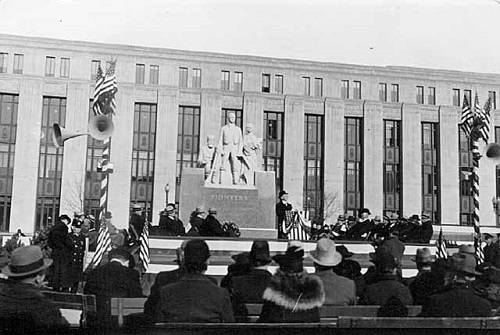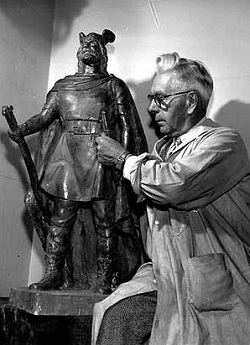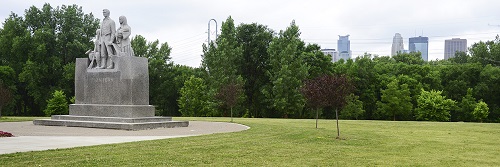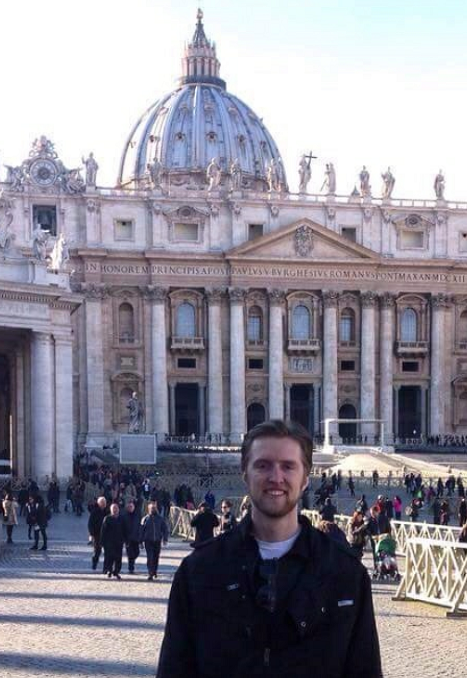The Pioneers Monument
 Monday, November 12, 2018 at 3:54AM |
Monday, November 12, 2018 at 3:54AM |  Michael Rainville Jr |
Michael Rainville Jr | Article by Michael Rainville, Jr.
Growing up in Northeast Minneapolis, I frequently passed by the stone sculpture depicting a family of pioneers on the corner of 5th Avenue and Marshall Street. It seemed like an odd place for a work of art, but I never really thought anything of it. As I grew older and the sculpture moved across the street to B.F. Nelson Park, I had to find out how this giant piece of granite found its way to Northeast. The journey of one of Minneapolis’ most forgotten icons is interesting to say the least, and it started half a mile south on the other side of the river in front of the downtown Minneapolis Post Office.
 1936 grand ceremony officially opening Pioneer Square.
1936 grand ceremony officially opening Pioneer Square.
The Great Depression was one of America’s darkest times, and while Minneapolis was not affected as much as other major cities, it still had its pockets of troubles. One of these areas was the block between 1st and 2nd Streets and Marquette and 2nd Avenues, which is now occupied by The Churchill Apartments. The city bought the block in the early 1930’s, installed walkways, benches, and a lawn, and in 1936, a grand ceremony took place to officially open Pioneer Square. This ceremony also celebrated the 103rd anniversary of the birth of Charles Loring, the first president of the Minneapolis Park Board. The focal point of the ceremony was the unveiling of a monument carved by the famous Norwegian-American Sculptor John Karl Daniels, and once the granddaughter of Charles Loring was done with her speech, the giant sheet was lifted off the sculpture and those in attendance were amazed by the grand monument.
 John Karl DanielsFunded by the Pillsbury family, John Karl Daniels’ 23-foot-tall, 500-ton St. Cloud granite sculpture towered over the rest of the park and greeted patrons of the post office as they made their way to its entrance. The sculptor depicted a pioneer family consisting of a father with a plow, a mother with a baby, and a sitting grandfather with an axe and rifle. Three generations of pioneers. Three generations of those who paved the way for the city’s residents. The back of the monument also has a relief that depicts Father Louis Hennepin receiving a peace pipe from a Dakota chief, another important moment of Minneapolis history.
John Karl DanielsFunded by the Pillsbury family, John Karl Daniels’ 23-foot-tall, 500-ton St. Cloud granite sculpture towered over the rest of the park and greeted patrons of the post office as they made their way to its entrance. The sculptor depicted a pioneer family consisting of a father with a plow, a mother with a baby, and a sitting grandfather with an axe and rifle. Three generations of pioneers. Three generations of those who paved the way for the city’s residents. The back of the monument also has a relief that depicts Father Louis Hennepin receiving a peace pipe from a Dakota chief, another important moment of Minneapolis history.
While the small park was nice to have in that part of town, it quickly drew interest for other uses. In the early 1940’s, a parking ramp was proposed for the site, and in 1951, a public atomic bomb shelter was even considered. The lack of maintenance on the park made it a less than ideal place to visit. A 74-year-old John Karl Daniels even got a ladder, bucket, and mop, and cleaned his artwork himself. As the years went on it became evident that the small park was more of a nuisance, and in 1967 it became no more. The Pioneer Monument was the only thing salvaged from the park, but moving it was a tall task. It was initially offered to anyone willing to move it, which greatly upset a now 90-year-old John Karl Daniels, as he thought his sculpture deserved much better.
The second home for the Pioneer Monument was a small triangular piece of land on 5th Avenue and Marshall Street NE. Not the best spot for such a sculpture. The very small triangular park was at a curve in the road, and many cars ended up crashing right into the monument. Also, the base the monument was put on was not properly built and started to sink into the ground as the decades passed. This once grand sculpture was now a forgotten piece of Minneapolis history. However, in 1993, the Saint Anthony West Neighborhood Organization board, which previously stopped the Interstate 335 expansion, now led by Michael Rainville, Sr., began discussing the possibility of raising money to move the monument. It took another ten years for plans to take shape, and the fundraising began. Finally, in 2010, the neighborhood board raised $75,000 to move the monument, clean it, and prepare its new spot across the street in the new B.F. Nelson Park.
 B.F. Nelson Park with the statue and skyline in the background. Photo credit Twin Cities Property Finder
B.F. Nelson Park with the statue and skyline in the background. Photo credit Twin Cities Property Finder
Seventy-four years and two parks later, the Pioneers Monument found its new, permanent home. While it’s a far cry from its original spot next to the downtown Minneapolis Post Office, the redeveloped B.F. Nelson Park is the perfect fit for this sculpture. John Karl Daniels can now rest easy knowing one of his most prideful works of art is being taken care of in a park that offers great views of the Mississippi riverfront. Now that the leaves have fallen, take a hike through B.F. Nelson, stop in front of the Pioneers Monument, and gaze at the perfect backdrop to this statue, the Minneapolis skyline.
- - - - - - - - - - - - - - - - - - - - - - - - - - - - - - - - - - - - - - -
 About Michael Rainville, Jr.
About Michael Rainville, Jr.
A 6th generation Minneapolitan, Michael Rainville Jr. received his B.A. in History from the University of St. Thomas, and is currently enrolled in their M.A. in Art History and Certificate in Museum Studies programs.
Michael is also a lead guide at Mobile Entertainment LLC, giving Segway tours of the Minneapolis riverfront for 6+ years.
He can be reached at mrainvillejr@comcast.net.
